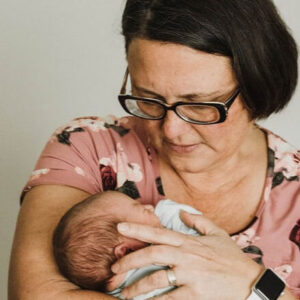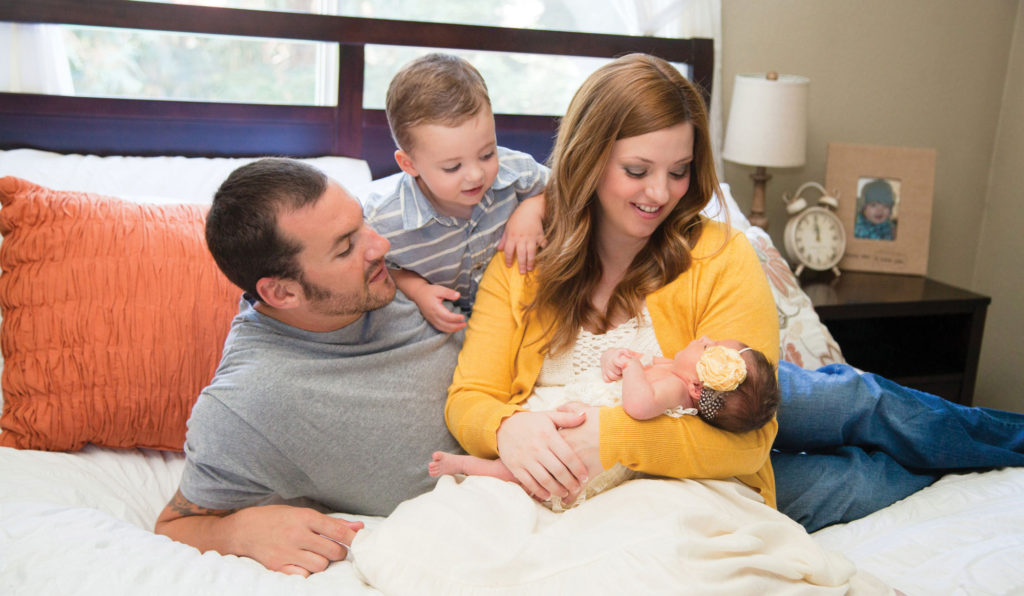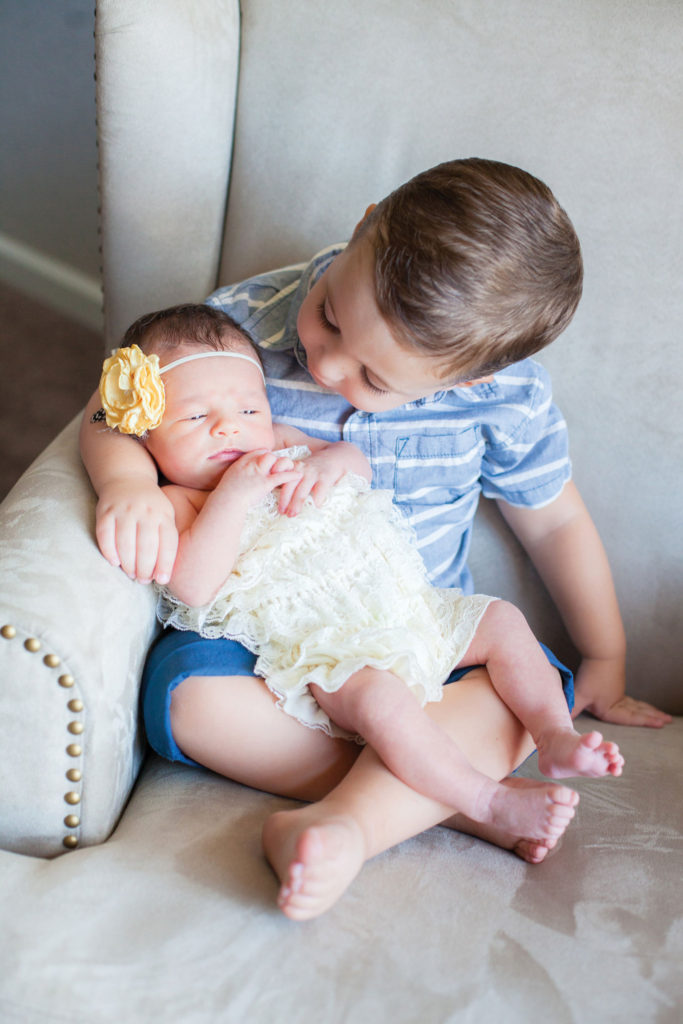Healthcare professionals don’t want to interrupt the euphoria of a beautiful birth by giving you too much information immediately, but once you are on your own with your baby you may have many questions about how to care for this new little one.
Before your baby arrives, it’s a good idea to get a general idea of what to expect, and to have some basics to refer to during the first few days after birth.
Everything you need to know about feeding
Immediate and continuous skin-to-skin contact between you and your baby after your birth helps you to breastfeed successfully. Your baby needs nothing beyond your colostrum (the milky fluid released before breast milk production begins) and your breast milk. Unless your midwife or pediatrician advises it, no supplementation of water or formula is necessary. Colostrum and breast milk are perfectly suited to fulfill all nutritional needs for your baby’s gestational age and they supply other factors to protect your baby from viral and other infections.
A newborn’s stomach only can hold about one small spoonful of milk, so don’t worry about how much you are producing. As long as your baby eats eight to ten times a day (with no more than three hours between feedings) and has plenty of wet and dirty diapers there is nothing to worry about. Just feed your baby according to their cues (rooting reflex, turning head to look for breast when cheek is gently stroked, sucking on hands or smacking or licking their lips).
Crying is a late sign that a baby is hungry and it may be more difficult to get baby latched and breastfeeding successfully. Avoid any artificial nipples of any kind, especially in the first few weeks. If you need to calm your baby until you can put him to your breast, a clean pinky finger (with a short fingernail) is a great to soothe him for a moment. Don’t worry if you think your baby is just suckling for comfort, because the more stimulation your breasts receive, the better and faster your milk supply will be produced. If your nipples become sore, turn to your provider for breastfeeding support or engage the services of a lactation consultant.
Both gas and spitting up are normal, common parts of being a baby. Burping your baby after each feeding helps reduce both. Massaging your baby’s belly in a clockwise pattern and bicycling or rolling your baby’s leg up to her chest can help move gas out. It is normal for babies to “spit up” (some milk dribbles out) with burping. If your baby is spitting up frequently after feeding, try holding her in an upright position for 20 minutes after nursing. Babies often go through stages when they want to breastfeed more frequently. Listen to your baby and you can be confident you are meeting their needs.
 How to know if your baby is too hot or too cold
How to know if your baby is too hot or too cold
It takes time for newborns to be able to regulate their body temperature. Until then, adding a light layer over the clothing the baby is wearing will be sufficient. If your baby is too hot, he may perspire. Check your baby’s hairline or the back of his neck to make sure he is not sweating. Wearing your baby in a carrier next to your body will also help keep baby at a comfortable temperature if the weather is cool.
Your midwife, pediatrician or a nurse in the hospital will teach you how to take your baby’s temperature correctly. I recommend a temporal artery thermometer to measure the temperature of the temporal artery in the forehead. Normal newborn temperature is about 97.5°-99.5° F (rectal or temporal). If your baby is warmer than this, think about whether or not she is overdressed, adjust the clothing, and recheck the temperature within 30-45 minutes. If your baby continues to have a temperature of 99.5° F or higher on two separate readings, she has a fever and you need to call your pediatrician or midwife. If baby is cooler add additional layers or place baby skin to skin and recheck the temperature within 30-45 minutes.
Your newborn’s skin and bathing tips
It is normal for a newborn’s skin to be dry and peeling for the first couple of weeks. You do not need to do anything special and this will resolve on its own. “Baby acne” is common, and does not require treatment. If your baby develops a rash with sores that have pus coming from them, you should contact your pediatrician or midwife. Babies are not dirty and do not need frequent baths after birth. Sponge baths are good for cleaning the genitals and the folds under his neck to keep him clean on a daily basis. Bathing with your baby can be a wonderful time to connect and provide skin to skin time. When shampooing your baby’s hair, using a soft baby brush to rub his scalp can prevent cradle cap.
Breathing patterns in newborns
Newborns’ breathing patterns tend to be irregular and you may notice you baby is breathing faster or slower at different times. Babies are still clearing the fluid from their lungs and airway after birth and they may make occasional snoring or snorting sounds. If your baby’s body is pink, then she is getting enough oxygen.
If you notice mucous from baby’s mouth and nose, simply wipe it away with a soft cloth. Suctioning is unnecessary. If your baby’s breathing seems labored (for example, grunting, or making soft sighing noises for every breath), if he is flaring his nostrils, if his chest is retracting during breathing (the sucking in of the skin between or around the rib cage) call your pediatrician or midwife. If your baby stops breathing or if the baby’s mouth or central body turns blue, call 911 immediately.
Best practices to help baby sleep safely
It is normal for babies to have a longer period of sleep within the first 24 hours of their birth. After that your baby should not sleep for more than three hours without feeding. When you put your baby down to sleep, the safest position is on the back. Sudden infant death syndrome (SIDS) has declined more than 50 percent since babies started sleeping on their backs instead of their tummies. Place your baby on her back on a firm, flat mattress in the crib.
Dress your baby in an extra nighttime sleeper for warmth rather than covering him with loose blankets. Using a single swaddling blanket is OK. Do not put pillows or toys in the baby’s bed that could cover his face. Having a fan turned on in your baby’s room may also be helpful in lowering the risk of SIDS for your baby.
Newborn bowel movements and wet diapers
Your baby’s first bowel movements will change from a black, thick tarry substance called meconium, to a thin brown to green stool, and then to a yellow gold, soft or mushy stool for breastfed babies, and a pale yellow, formed and pasty stool in formula fed infants. Keeping the baby’s bottom lightly lubricated with coconut oil makes clean-up of meconium easier. The urine should be clear or pale yellow. You may notice a pinkish or rust colored stain in your baby’s diaper. This is normal for the first 3 to 4 days. It is caused by uric acid crystals that occur when the baby’s urine is concentrated and indicates that it is important to feed your baby as often as possible.
The umbilical cord
The umbilical cord stump usually falls off 4-14 days after birth. Keep clothing and diapers from rubbing against the cord as much as possible. If you notice any odor, oozing of pus, or reddening around the cord call your pediatrician or midwife. Never pull on the cord or attempt to loosen it.
Keeping your baby’s eyes healthy
It is common for a newborn to have red spots in the whites of the eyes after birth due to broken blood vessels. These will go away on their own. Frequently babies will have discharge from the eyes since their tear ducts aren’t fully functional right away. If your baby’s eyes get yellow-green discharge or become crusty, you can wipe them with a damp, clean cotton gauze. Breast milk is antibacterial, and putting some in baby’s eyes may help. It also helps to gently massage these tear ducts. Wash you hands, then massage in a circular motion from the outside of the eye towards your baby’s nose. Both the bottom and top eyelids can be done 2-3 times per day.
Cutting your newborn’s fingernails
Some newborns enter the world with fingernails so long that they need to be cut right away to prevent them from scratching their faces. Resist the urge to use mittens on your baby’s hands. Baby’s need to learn how to use their hands to explore their world and they cannot do that with mittens on. To clip your baby’s fingernails, use a pair of baby scissors or clippers made specially to use on tiny fingers.
The appearance of breasts and genitals
Your baby may have prominent breast buds after birth and could even secrete a few drops of pale white liquid due to the maternal hormones in their system. This is not a concern, and will resolve itself. These hormones also may cause the labia or scrotum to be enlarged. It is also possible for girls to pass some mucous and possibly blood from her vagina for up to a few days. This is from the mother’s hormones and is normal. This is not a cause for worry. Girls should be wiped from front to back to avoid dragging stool into the vagina and urethra. Do not retract your son’s foreskin to clean his penis at diaper changes. Simply wipe the area that you can see.
Your routine schedule of visits with the midwife for well-baby care will be as follows:
- 24-48 hours
- 1-2 weeks
- 4-6 weeks of age
The suggested schedule with your pediatrician or family doctor for well-baby checks is:
- Every 2 months from 2– 6 months of age
- Every 3 months from 6– 18 months of age
- Every 6 months from 18– 24 months of age
- Annually from 2– 5 years of age
As a new parent, you want to do everything you can to make sure your baby is healthy and happy. That’s why it’s important to learn about newborn care before your little one arrives.
A midwife is qualified to provide well-baby care in the early weeks after delivery. They can provide guidance on everything from breastfeeding to baby’s first vaccinations. Most babies will see a pediatrician within the first few weeks of life. This is an important check-up to make sure your baby is growing and developing as they should be.
It’s normal for new parents to feel overwhelmed at times. Don’t hesitate to ask friends or family for support. Your success and wellness is our first priority as care providers don’t forget to ask lots of questions. That is what we are here for!
Posted in: Health & Nutrition
Comment Policy: All viewpoints are welcome, but comments should remain relevant. Personal attacks, profanity, and aggressive behavior are not allowed. No spam, advertising, or promoting of products/services. Please, only use your real name and limit the amount of links submitted in your comment.
You Might Also Like...
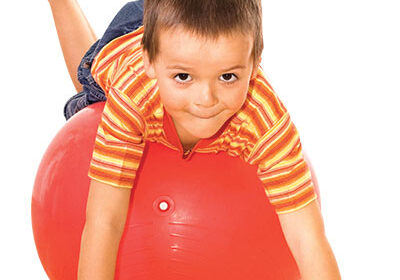
Toddlers Need Exercise Too!
Cardio is not only for adults. With the growing childhood obesity problem, it’s important to get your older baby and toddler up and active. It’s easy to do, as young […]
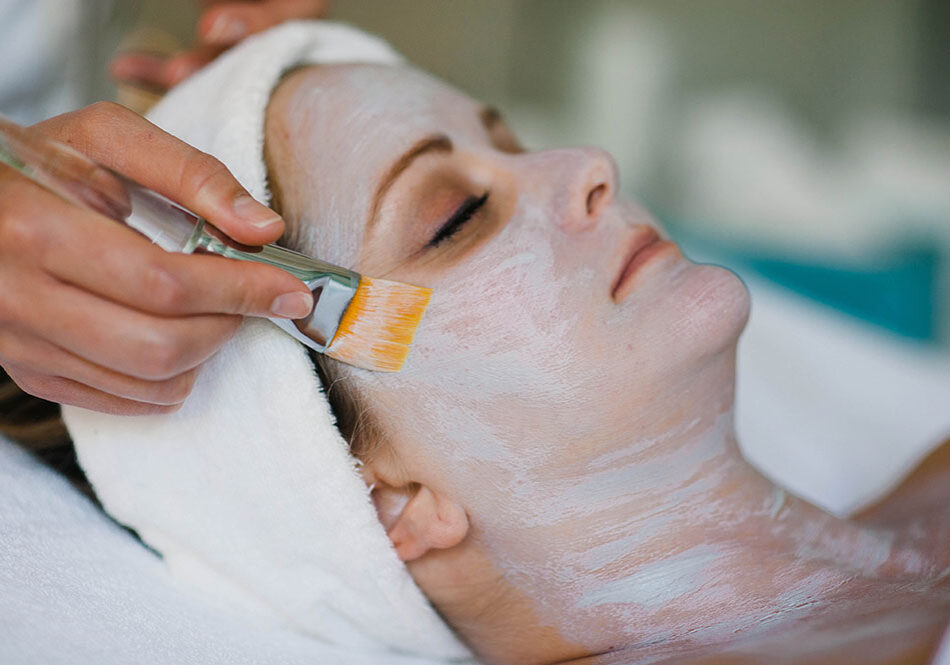
Achieving Clear Skin – Three Common Mistakes Acne Sufferers Make
As many teens can attest, acne is a very unpleasant skin condition that has physical, emotional and social consequences. Unfortunately, the problem is frequently made worse by three very common […]

Talking to Boys About Body Image and Disordered Eating
When Kristine Strange talks about fitness with her two school-age sons, she’s careful to focus on effort, rather than physical appearance. “We talk about how strong our bodies are and […]

Hydration Tips For Young Athletes
Your little sports enthusiast has been practicing hard in the late-summer heat of northern California for an hour. Your athlete runs over to you, smiling, sweaty, and thirsty. You reach […]


